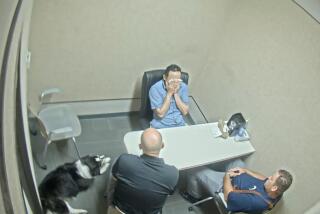Peyer to Be Tried in Knott Slaying; Suspicion ‘Strong’
- Share via
CHP Officer Craig Peyer was ordered to stand trial Monday for murder in the strangulation of San Diego State University student Cara Knott, whose body was thrown off a bridge.
In binding Peyer over for trial, Municipal Court Judge Frederic L. Link said: “The court finds a strong suspicion that (Peyer) committed the crime.”
Peyer, 37, and a 13-year California Highway Patrol veteran, showed no emotion. He is on paid administrative leave and is free on $1 million bail.
CHP Has No Comment
CHP spokeswoman Susan Cowan-Scott said CHP officials have no comment on Link’s ruling. She said Peyer will continue to draw his $33,000-a-year salary until he is served with the findings of an internal investigation and has a chance to respond.
Peyer is expected to be served “within a matter of days,” Cowan-Scott said, and will have five days to contest the department’s findings. She would not say what the department had concluded.
Knott, 20, was strangled on the old U.S. 395 bridge on the night of Dec. 27 in an isolated area near Interstate 15 and the Mercy Road off-ramp. Police said she was killed between 9 and 10 p.m. and her body thrown 65 feet into a dry creek bed, where it was discovered the next morning.
An autopsy report said Knott was killed before she was thrown from the bridge and had not been sexually assaulted. However, she suffered massive internal injuries as a result of the long fall.
Monday’s hearing featured a final witness for the prosecution and four witnesses for the defense. Deputy Dist. Atty. Joseph van Orshoven called 57 witnesses during the five-day preliminary hearing, including a blood-typing expert who said Monday that Peyer’s blood type matches a small blood spot found on Knott’s blood-soaked sweat shirt.
Gary Harmor, a serologist with the Serological Research Institute in the San Francisco Bay Area, said he found the blood at the top of the left sleeve of Knott’s sweat shirt.
“It was on the surface of the sweat shirt . . . fairly diffused, spotty,” Harmor said. “The stain was approximately 1 inches by three-quarter inches.”
Harmor said that he used a complex and sophisticated scientific test called “absorption inhibition” to match the so-called genetic markers derived from the blood spot on the sweat shirt to genetic qualities found in a sample of Peyer’s blood. The process uses commercially produced antibodies and matches them to specific antigens (enzymes) found in red blood cells.
The absorption inhibition process is so high-tech that only five laboratories in the United States, including the SRI lab in the Bay Area and another in Los Angeles County, are capable of conducting this type of test, Harmor said. The test uses designates for serum protein called KM and GM markers to match blood samples.
Unique Blood Markers
KM and GM markers have unique genetic identifying characteristics. The more KM and GM markers that can be tested, the greater the probability of identifying the source of a blood sample, said Harmor. In matching the single blood stain on Knott’s sweat shirt to Peyer’s blood type, Harmor said that he tested two KM and six GM factors found in the spot.
Though Harmor did not say that the blood spot on the sweat shirt definitely came from Peyer, he said that only 1.33% of the world’s population has similar genetic markers in their blood. This percentage amounts to one in every 75 Caucasians and not at all in non-Caucasians, Harmor said.
The blood stain on the sweat shirt could not have come from Knott, Harmor said, adding that the tests concluded that the donor of the stain has blood Type A. Knott was Type O. Harmor and San Diego police serologist Walter K.W. Fung testified that Peyer has Type A.
Harmor said that he received Knott’s sweat shirt and three other articles of clothing from San Diego police on Jan. 22, a week after Peyer’s arrest. Testing on the clothing continued until the first week in March, he said.
Diane Campbell, a defense attorney for Peyer, argued unsuccessfully against allowing Harmor to testify. Campbell objected to Harmor’s testimony on grounds that the testing method he used is “novel and new,” but Link turned down her argument.
Serologists have matched Peyer’s blood type to two articles of clothing worn by Knott on the night she died. Fung testified last week that he found a “crusty” blood spot in a crease of Knott’s left boot that matched Peyer’s Type-A blood.
Scratches Become Issue
On Monday, the controversy over scratches that some witnesses saw on Peyer’s face the night of the killing was raised anew. Several witnesses, including some CHP officers, testified that they noticed scratches and blood on Peyer’s face after the time that Knott was strangled.
Karen Anderson and Shirley Schwartz, both former employes of a service station on Kearny Villa Road, testified last week that they saw scratches and blood on Peyer’s face when he pulled into their service station Dec. 27, between 9:30 p.m. and 10 p.m., to buy gasoline for his patrol car. Prosecutors contend Peyer went to the station shortly after Knott was killed.
But Anderson’s son-in-law, Morris Hahn, and her daughter, Tammy Hahn, testified Monday that they did not see the scratches. The Hahns, who were subpoenaed by the defense, said they were visiting Anderson the night that Peyer pulled into the station to buy gasoline.
While Anderson and Schwartz said they saw Peyer between 9:30 p.m. and 10 p.m., Morris Hahn, a San Diego police officer, said that Peyer actually drove into the station between 10 p.m. and 10:30 p.m. Hahn said that he maded eye contact with Peyer from about 2 to 3 feet and did not see any scratch marks on Peyer’s face.
Tammy Hahn said she could not identify Peyer as the CHP officer who purchased gasoline that night but said the officer she saw did not have a scratched face. Morris Hahn was never asked by the prosecution or defense to identify Peyer.
Scratches Blamed on Fence
Peyer said he suffered the scratches on his face when he slipped at the CHP office while filling his cruiser with gas at the end of his Dec. 27 shift. According to Peyer, the scratches resulted when his face rubbed against a chain link fence at the end of his shift.
None of the CHP officers who worked with Peyer on Dec. 27 and who testified at the preliminary hearing said he saw Peyer fall at the CHP office. One CHP officer said he noticed the scratches about 10:30 p.m., at the end of the shift. Anderson and Schwartz said they noticed the scratches on Peyer’s face as much as an hour before his shift ended.
Prosecutors contend that the scratches were inflicted by Knott, who was trained in a self-defense class to claw, scratch and gouge the eyes of an attacker.
Donna Bodine, an administrator at Palomar Hospital, testified Monday that on Dec. 27 she drove onto southbound Interstate 15 from the Via Rancho Parkway on-ramp at 8:15 p.m. As she drove on the on-ramp, an unidentified man lunged at her car, she said.
“A man jumped out at my car. He lunged toward my car, and I swerved to miss him,” said Bodine, who testified for the defense.
During the five-day preliminary hearing, defense attorney Robert Grimes has hammered away at several prosecution witnesses and asked repeatedly whether they took a liver temperature of Knott’s body to determine a more exact time of death. Grimes’ apparent strategy is to show that Knott could have been killed earlier or later than the time of death indicated by police and the coroner’s office.
Deputy Coroner Daniel Matticks testified Monday that a liver temperature was taken at the morgue but not at the murder scene because it is not the coroner’s policy to take liver temperatures of homicide victims at the scene. Matticks said he arrived at the murder scene at 10:10 a.m. Dec. 28, almost two hours after Knott’s body was discovered. He said the body was in rigor and cold to the touch when he examined it.
The list of scientific evidence presented against Peyer included a microscopic piece of gold thread found on Knott’s sweat shirt. A police hair-fiber expert testified last week that the thread matched thread samples found on CHP patches taken from Peyer’s uniform jacket.
Trial Strategy Hinted
In questioning prosecution witnesses about the thread and other pieces of evidence, Grimes further revealed the strategy that he might use at Peyer’s trial. Grimes repeatedly asked the various witnesses questions about where they examined the clothing worn by Knott and Peyer, and confiscated by homicide investigators.
Grimes has suggested that the evidence may have been contaminated in the police evidence room at the forensic laboratory. He has raised the possibility that the items of clothing may have been lain on top of each other, or close enough for contamination.
Link bound Peyer over for trial after listening to 57 witnesses produced by the prosecution over a five-day period. Nineteen young women testified that Peyer pulled them over while they were driving at night on Interstate 15 and ordered them to drive down the darkened Mercy Road off-ramp, where he engaged some women in conversations that lasted as long as one hour and 40 minutes. All of the women testified that Peyer stopped them for minor infractions, usually for having a faulty headlight or taillight.
The women said they were stopped in 1986 and Peyer never touched them or asked them for a date. But Link said Peyer’s conduct “in luring young women to a darkened Mercy Road off-ramp” was “outside the policy of the CHP.”
Peyer will return to court May 18, when a Superior Court judge will set a trial date. The case is expected to go to trial in July.
Peyer is the second CHP officer ever charged with committing murder while on duty. In 1984, George M. Gwaltney was convicted in a civil rights homicide case stemming from the rape of a young woman whom he stopped in the desert near Barstow.
More to Read
Sign up for Essential California
The most important California stories and recommendations in your inbox every morning.
You may occasionally receive promotional content from the Los Angeles Times.













